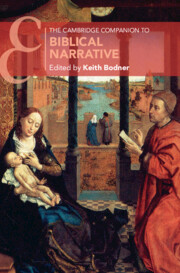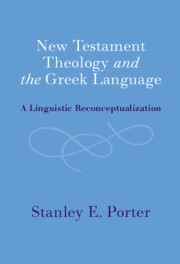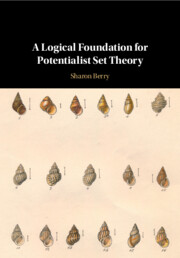42 results
1 - The Literary Worlds of Genesis
-
-
- Book:
- The Cambridge Companion to Biblical Narrative
- Published online:
- 30 January 2025
- Print publication:
- 06 February 2025, pp 12-36
-
- Chapter
- Export citation

The Cambridge Companion to Biblical Narrative
-
- Published online:
- 30 January 2025
- Print publication:
- 06 February 2025
3 - The Building Blocks of a Republican Competition Law Approach
- from Part II - The Operationalisation of the Competition–Democracy Nexus
-
- Book:
- Competition Law and Democracy
- Published online:
- 21 November 2024
- Print publication:
- 28 November 2024, pp 103-136
-
- Chapter
- Export citation
4 - The Competition–Democracy Nexus in US Antitrust and EU Competition Law Jurisprudence
- from Part II - The Operationalisation of the Competition–Democracy Nexus
-
- Book:
- Competition Law and Democracy
- Published online:
- 21 November 2024
- Print publication:
- 28 November 2024, pp 137-170
-
- Chapter
- Export citation
Chapter 23 - Linguistics and Philology in Dictionaries
- from Part IV - Dictionaries and Domains of Use
-
-
- Book:
- The Cambridge Handbook of the Dictionary
- Published online:
- 19 October 2024
- Print publication:
- 31 October 2024, pp 460-480
-
- Chapter
- Export citation
Chapter 7 - From Structuralism to Poststructuralism
-
- Book:
- Intellectual History and the Problem of Conceptual Change
- Published online:
- 02 May 2024
- Print publication:
- 09 May 2024, pp 145-166
-
- Chapter
- Export citation
Chapter 10 - Behind the Structures and the Subject
-
- Book:
- Intellectual History and the Problem of Conceptual Change
- Published online:
- 02 May 2024
- Print publication:
- 09 May 2024, pp 210-227
-
- Chapter
- Export citation
4 - Theoretical Approaches
- from Part I - Contexts
-
-
- Book:
- The Cambridge History of Old Norse-Icelandic Literature
- Published online:
- 08 February 2024
- Print publication:
- 29 February 2024, pp 72-90
-
- Chapter
- Export citation
32 - Literary Theory, Criticism, and the Essay
- from Part IV - Toward the Contemporary American Essay (2000–2020)
-
-
- Book:
- The Cambridge History of the American Essay
- Published online:
- 28 March 2024
- Print publication:
- 14 December 2023, pp 545-564
-
- Chapter
- Export citation
ONTOLOGICAL PURITY FOR FORMAL PROOFS
- Part of
-
- Journal:
- The Review of Symbolic Logic / Volume 17 / Issue 2 / June 2024
- Published online by Cambridge University Press:
- 13 November 2023, pp. 395-434
- Print publication:
- June 2024
-
- Article
-
- You have access
- Open access
- HTML
- Export citation
9 - Ordering Principles
- from Part II - Waltzian Structural Theory
-
- Book:
- Systems, Relations, and the Structures of International Societies
- Published online:
- 19 October 2023
- Print publication:
- 02 November 2023, pp 153-174
-
- Chapter
- Export citation

Structure and Function
-
- Published online:
- 14 February 2023
- Print publication:
- 09 March 2023
-
- Element
- Export citation
13 - Founding of Modern Psychology
- from Part I - Psychology’s Historical Foundations
-
- Book:
- History and Systems of Psychology
- Published online:
- 04 November 2022
- Print publication:
- 17 November 2022, pp 241-264
-
- Chapter
- Export citation
2 - The Burger and Rehnquist Courts
-
- Book:
- Post-Racial Constitutionalism and the Roberts Court
- Published online:
- 27 October 2022
- Print publication:
- 03 November 2022, pp 34-86
-
- Chapter
- Export citation

New Testament Theology and the Greek Language
- A Linguistic Reconceptualization
-
- Published online:
- 13 October 2022
- Print publication:
- 20 October 2022
Chapter 1 - Coherence
-
- Book:
- Seneca's Characters
- Published online:
- 23 June 2022
- Print publication:
- 07 July 2022, pp 23-98
-
- Chapter
-
- You have access
- Open access
- HTML
- Export citation
Introduction
-
- Book:
- Seneca's Characters
- Published online:
- 23 June 2022
- Print publication:
- 07 July 2022, pp 1-22
-
- Chapter
-
- You have access
- Open access
- HTML
- Export citation
17 - Logicism and Structuralism
- from Part III
-
- Book:
- A Logical Foundation for Potentialist Set Theory
- Published online:
- 10 February 2022
- Print publication:
- 17 February 2022, pp 183-188
-
- Chapter
- Export citation

A Logical Foundation for Potentialist Set Theory
-
- Published online:
- 10 February 2022
- Print publication:
- 17 February 2022
3 - The New Social, Economic and Labour History
-
- Book:
- History and Identity
- Published online:
- 04 February 2022
- Print publication:
- 20 January 2022, pp 59-79
-
- Chapter
- Export citation

